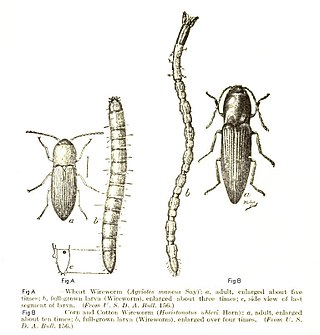
Elateridae or click beetles are a family of beetles. Other names include elaters, snapping beetles, spring beetles or skipjacks. This family was defined by William Elford Leach (1790–1836) in 1815. They are a cosmopolitan beetle family characterized by the unusual click mechanism they possess. There are a few other families of Elateroidea in which a few members have the same mechanism, but most elaterid subfamilies can click. A spine on the prosternum can be snapped into a corresponding notch on the mesosternum, producing a violent "click" that can bounce the beetle into the air. Clicking is mainly used to avoid predation, although it is also useful when the beetle is on its back and needs to right itself. There are about 9300 known species worldwide, and 965 valid species in North America.
Glowworm or glow-worm is the common name for various groups of insect larvae and adult larviform females that glow through bioluminescence. They include the European common glow-worm and other members of the Lampyridae, but bioluminescence also occurs in the families Elateridae, Phengodidae and Rhagophthalmidae among beetles; as well as members of the genera Arachnocampa, Keroplatus and Orfelia among keroplatid fungus gnats.

The Elateroidea are a large superfamily of beetles. It contains the familiar click beetles, fireflies, and soldier beetles and their relatives. It consists of about 25,000 species.
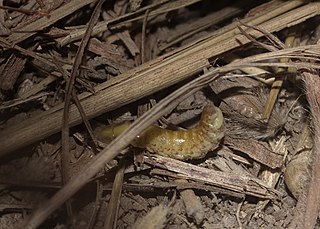
The Rhagophthalmidae are a family of beetles within the superfamily Elateroidea. Members of this beetle family have bioluminescent organs on the larvae, and sometimes adults, and are closely related to the Phengodidae, though historically they have been often treated as a subfamily of Lampyridae, or as related to that family. Some recent evidence suggested that they were the sister group to the Phengodidae, and somewhat distantly related to Lampyridae, whose sister taxon was Cantharidae, but more reliable genome-based phylogenetics placed as the sister group to the Lampyridae.
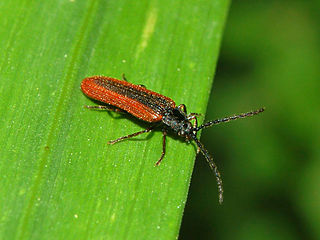
The Omalisinae are a small subfamily of morphologically derived elaterid beetles. The Omalisinae were long considered an independent family in the deprecated family Cantharoidea, and later a family in the Elateroidea, but molecular phylogenies have demonstrated the morphological similarity of Omalisinae to other soft bodied beetles is a case of parallel evolution (homoplasy) of their soft bodies, rather than an apomorphy. Members of this beetle subfamily have been reported to have bioluminescent organs on the larvae, although no recent publications have confirmed this. Some recent evidence indicated they were the sister group to a clade comprising the families Rhagophthalmidae and Phengodidae, however a more comprehensive phylogenetic analysis based on genome sequences strongly supported the Omalisinae as being contained within the Elateridae.

Rhinorhipus is a genus of beetles that contains a single species, Rhinorhipus tamborinensis from southern Queensland, Australia. It is the sole member of the family Rhinorhipidae and superfamily Rhinorhipoidea. It is an isolated lineage not closely related to any other living beetle, estimated to have split from other beetles at least 200 million years ago, with studies either considering them the earliest diverging member of Elateriformia, or a basal lineage within Polyphaga. They exhibit feigning death (thanatosis) when disturbed. Their ecology is poorly known. It is likely that they are fossorial based on their morphology.

Drilini is a tribe of beetles known commonly as the false firefly beetles, in the family Elateridae.

Eucnemidae, or false click beetles, are a family of elateroid beetles including about 1700 species distributed worldwide.

Omethidae is a family of Elateroidea sometimes known as the false soldier beetles. They are native to South, Southeast and Eastern Asia and the Americas. Their biology is obscure and their larvae are unknown. They appear to inhabit vegetation in or surrounding forests, and are probably active during the day.
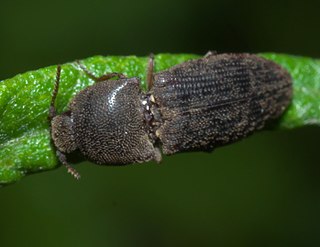
Agrypninae is a subfamily of click beetles in the family Elateridae. There are at least 130 genera and more than 430 described species in Agrypninae.

Oxynopterini is a tribe of click beetles in the subfamily Dendrometrinae.
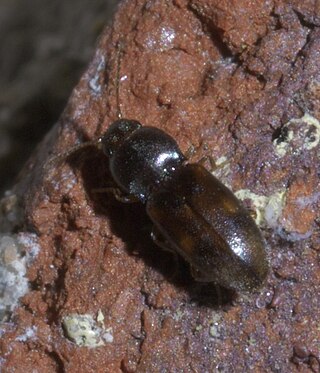
Negastriinae is a subfamily of click beetles in the family Elateridae.

The Pyrophorini are a New World taxonomic tribe within the Elateridae subfamily Agrypninae. Pyrophorini is a tribe of bioluminescent beetles, and includes such genera as Pyrophorus and Ignelater.
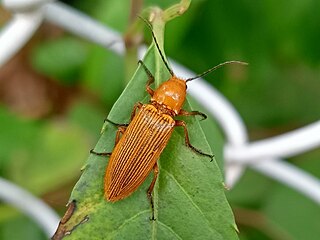
Hemiopinae is a subfamily of click beetles in the family Elateridae. There are at least four genera in Hemiopinae.
Oestodinae is a subfamily of click beetles in the family Elateridae. There are at least two genera in Oestodinae.

Parablacinae is a subfamily of click beetles in the family Elateridae. There are about eight genera in Parablacinae.
Physodactylinae is a subfamily of click beetles in the family Elateridae. There are at least two genera in Physodactylinae.
Pityobiinae is a subfamily of click beetles in the family Elateridae. There are at least two genera and two described species in Pityobiinae.

Sinopyrophorus is a genus of bioluminescent hard-bodied clicking beetles in the superfamily Elateroidea, and is the sole member of the recently recognized family Sinopyrophoridae. The genus currently contains a single species, Sinopyrophorus schimmeli, which was described in 2019 from the subtropical evergreen broadleaf forests of western Yunnan, China.

The Lycini is a species-rich beetle tribe belonging to the subfamily Lycinae















